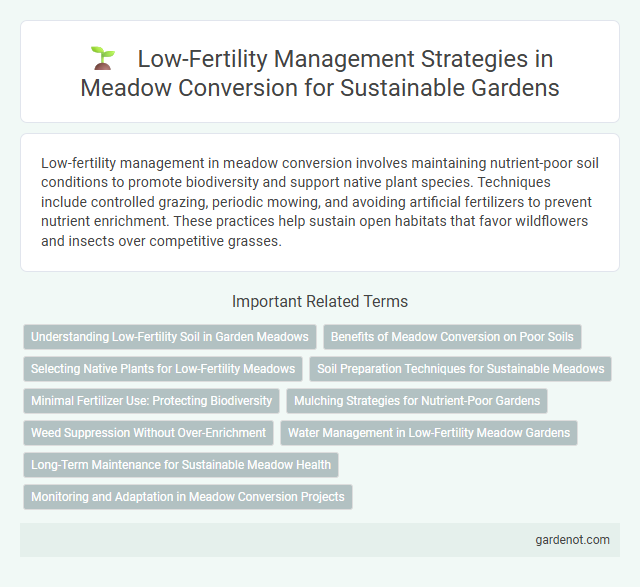Low-fertility management in meadow conversion involves maintaining nutrient-poor soil conditions to promote biodiversity and support native plant species. Techniques include controlled grazing, periodic mowing, and avoiding artificial fertilizers to prevent nutrient enrichment. These practices help sustain open habitats that favor wildflowers and insects over competitive grasses.
Understanding Low-Fertility Soil in Garden Meadows
Low-fertility soils in garden meadows typically have limited nutrient availability, characterized by low nitrogen, phosphorus, and potassium levels crucial for plant growth. Managing these soils requires selecting native and wildflower species adapted to nutrient-poor conditions, which promotes biodiversity and reduces reliance on fertilizers. Soil testing and organic matter addition can gradually improve structure and microbial activity, enhancing nutrient cycling without disrupting the meadow ecosystem.
Benefits of Meadow Conversion on Poor Soils
Meadow conversion enhances soil structure and increases organic matter in low-fertility soils, promoting nutrient retention and microbial activity. This process improves water infiltration and reduces erosion, leading to sustainable land use and higher productivity on otherwise marginal land. Consequently, it supports biodiversity by providing habitat for native plant and animal species adapted to poor soil conditions.
Selecting Native Plants for Low-Fertility Meadows
Selecting native plants adapted to low-fertility soils enhances meadow resilience by promoting natural nutrient cycling and reducing the need for artificial fertilization. Species such as wild lupine, little bluestem, and purple coneflower thrive in nutrient-poor conditions and support local biodiversity. Prioritizing these natives improves soil structure and fosters a sustainable ecosystem in low-fertility meadow conversions.
Soil Preparation Techniques for Sustainable Meadows
Soil preparation techniques for sustainable meadows emphasize low-fertility management by minimizing nutrient inputs to promote native plant diversity and resilience. Practices include shallow tillage to reduce soil disturbance, maintaining organic mulch layers to enhance soil structure, and using cover crops to suppress weeds while gradually improving soil biology without excessive fertilization. These methods support balanced nutrient cycling essential for long-term meadow health and biodiversity conservation.
Minimal Fertilizer Use: Protecting Biodiversity
Minimal fertilizer use in meadow conversion supports low-fertility management by preserving native plant species and maintaining soil health. Limiting nutrient inputs prevents dominance by aggressive species, fostering biodiversity and enhancing habitat quality. This approach promotes sustainable ecosystems by balancing productivity with ecological integrity.
Mulching Strategies for Nutrient-Poor Gardens
Mulching strategies significantly improve soil moisture retention and nutrient availability in low-fertility meadow conversions by suppressing weed growth and reducing erosion. Organic mulches, such as straw, wood chips, or leaf litter, decompose slowly, releasing essential nutrients like nitrogen and phosphorus to support nutrient-poor garden ecosystems. Applying a 5-10 cm mulch layer enhances microbial activity, promoting soil health and facilitating sustainable plant growth in degraded or infertile meadow soils.
Weed Suppression Without Over-Enrichment
Low-fertility management in meadow conversion emphasizes suppressing invasive weeds by maintaining nutrient-poor soils that limit aggressive species proliferation without causing over-enrichment. This approach utilizes controlled grazing and selective mowing to reduce weed dominance while preserving native wildflower diversity. Maintaining balanced soil nitrogen levels prevents eutrophication and supports long-term ecosystem stability.
Water Management in Low-Fertility Meadow Gardens
Effective water management in low-fertility meadow gardens enhances soil moisture retention and promotes native plant resilience by minimizing nutrient leaching and erosion. Techniques such as drip irrigation, mulching, and contour planting optimize water distribution, supporting diverse meadow ecosystems under nutrient-poor conditions. Sustainable water practices improve meadow productivity while preserving the ecological balance essential for low-fertility habitats.
Long-Term Maintenance for Sustainable Meadow Health
Long-term meadow health relies on low-fertility management techniques that prevent nutrient accumulation and discourage invasive species. Regular mowing combined with targeted, minimal fertilization maintains soil nutrient balance and promotes native wildflower diversity. Implementing rotational grazing or hay cutting supports sustainable meadow ecosystems by enhancing plant resilience and biodiversity over time.
Monitoring and Adaptation in Meadow Conversion Projects
Monitoring soil nutrient levels and plant biodiversity is essential for effective low-fertility management in meadow conversion projects. Adaptive management strategies, such as adjusting grazing intensity and mowing schedules based on real-time ecological data, help maintain species-rich grasslands. Continuous evaluation ensures restoration goals are met while minimizing nutrient inputs and environmental impact.
Low-fertility management Infographic

 gardenot.com
gardenot.com